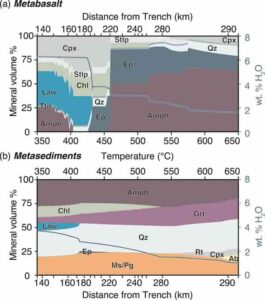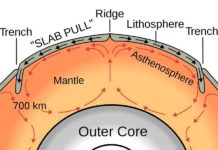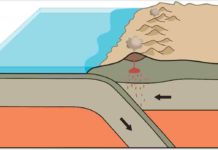
The Mexican state of Guerrero, located on the country’s Pacific coast, is known for its rich cultural history and for iconic beach destinations like Acapulco. It is also home to a geologically curious subduction zone.
The subduction zone beneath Guerrero is formed by the Cocos plate sliding beneath the North American plate and is shaped in part by a fault-slip phenomenon known as episodic tremor and slow slip (ETS). In contrast to more common slip behaviors such as earthquakes, scientists understand relatively little about how ETS deforms tectonic plates.
P. C. Lindquist and colleagues developed petrologic models to study the variables that drive ETS, focusing on Guerrero as a natural laboratory for plate deformation research. Specifically, the authors investigate how the chemical alteration, or metasomatism, of serpentinized peridotite rock produces talc in the subduction zone. Talc is a weak, hydrous mineral that can preferentially host deformation in subduction zones and, the authors suggest, may facilitate ETS at subduction zone interfaces.
With their petrologic models, the researchers predicted mineral occurrences at the plate interface beneath Guerrero using realistic pressure, temperature, and composition conditions. They found that where ETS occurs in the subduction zone, serpentinites must react with enough of the fluids being released by the subducting Cocos plate to reach 43% silica by weight for talc to form. However, even small silica additions beyond that amount result in significant volumes of talc at the plate interface that should then host deformation in the subduction zone.
The team’s models also predicted that talc grows in serpentinite mainly where subducting basalts undergo enough dehydration to produce sufficient volumes of silica-rich fluid.
Although the models did not replicate the large, geophysically inferred talc volume in the subduction zone beneath Guerrero, they did predict the formation of thin zones of talc-rich rocks near where ETS occurs along the plate interface. The research, according to the authors, shows the importance of including metasomatism in fault slip models, and it provides direction for future research studying seismicity along Mexico’s Pacific coast.
Reference:
P. C. Lindquist et al, Metasomatism and Slow Slip: Talc Production Along the Flat Subduction Plate Interface Beneath Mexico (Guerrero), Geochemistry, Geophysics, Geosystems (2023). DOI: 10.1029/2023GC010981
Note: The above post is reprinted from materials provided by Aaron Sidder, American Geophysical Union.










